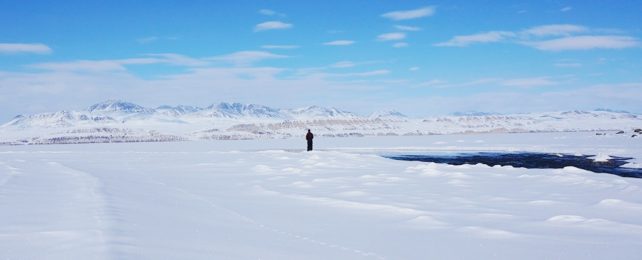As the world warms and glacier melt continues, the Arctic could become "fertile ground" for new viral pandemics, with climate change increasing the risk of the next Ebola, influenza, or SARS-CoV-2 arriving sooner rather than later.
In a new study, researchers looked at soil and lake sediment from Lake Hazen, the largest lake by volume north of the Arctic Circle. Sequencing segments of DNA and RNA found in the soil, the scientists sought to identify the pool of viruses present in the environment.
Using a computer algorithm to contextualize the viruses with animal, plant, and fungi hosts present in the area, the team was able to figure out the viral spillover risk: that is, the ability for viruses to flood into new host species and keep spreading, as SARS-CoV-2 did by moving from populations of wild animals into humans.
"Spillover risk increases with runoff from glacier melt, a proxy for climate change," write the researchers in their published paper.
"Should climate change also shift species range of potential viral vectors and reservoirs northwards, the High Arctic could become fertile ground for emerging pandemics."
The researchers compared the evolutionary path of both viruses and hosts, looking for variations and similarities between the two – comparisons that suggest the possibility of a change to the status quo and subsequent viral spillover.
"From an evolutionary standpoint, viruses are more prone to infecting hosts that are phylogenetically close to their natural host, potentially because it is easier for them to infect and colonize species that are genetically similar," the researchers explain in their paper.
In line with previous studies, which show how degraded landscapes can thrust pathogens, parasites and hosts together in new ways, the researchers suggest that increased glacier runoff leads to greater chances of viruses jumping over into eukaryote hosts.
The increased spillover risk differed, though, in the soil and lake sediment samples. In soil, with high glacial melt flows, the spillover risk increased to a point before declining, whereas the risk continued rising in lake sediment samples.
One explanation put forward by the researchers is that increased runoff means more organic material – and the organisms in it – gets washed into the lake rather than remaining on land.
"As the climate changes, the metabolic activity of the Arctic's microbiosphere also shifts, which in turn affects numerous ecosystem processes such as the emergence of new pathogens," write the researchers.
The High Arctic – that is, the northernmost regions – is one part of the world most vulnerable to climate change. Over the last couple of decades, a third of Arctic Ocean winter ice has disappeared.
At the same time, scientists are also warning of an increased risk of pandemics caused by multiple factors: not least human activity destroying natural habitats and forcing animals and people to live in increasingly close quarters.
The urgent need to understand the relationship between habitat change and proximity to new disease sources underpins this latest study – and with global warming likely to lead to species heading further north to maintain an environment with the same sort of temperatures, the potential for viruses to jump to new species grows even further.
"This twofold effect of climate change, both increasing spillover risk and leading to a northward shift in species ranges, could have dramatic effects in the High Arctic," write the researchers.
"Disentangling this risk from actual spillovers and pandemics will be a critical endeavor to pursue in parallel with surveillance activities."
The research has been published in Proceedings of the Royal Society B: Biological Sciences.
